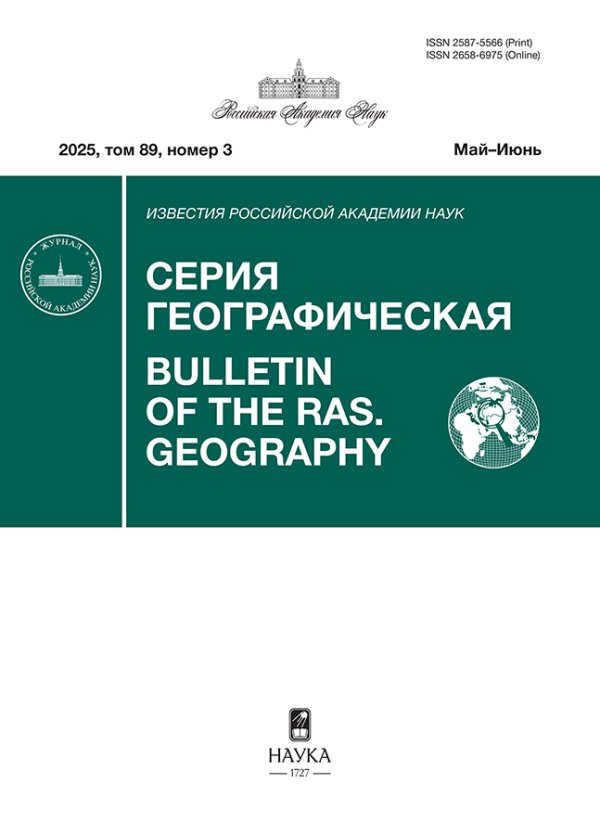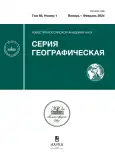Том 88, № 1 (2024)
ПРИРОДОПОЛЬЗОВАНИЕ И ГЕОЭКОЛОГИЯ
Пути экологизации сельскохозяйственного землепользования в трансграничных сухостепных ландшафтах Кулунды
Аннотация
Засушливые территории подвержены процессам деградации, обусловленным природными и антропогенными факторами, среди последних по масштабу и продолжительности воздействия выделяется сельскохозяйственная деятельность. Включение эколого-ландшафтных принципов в систему стратегического управления землепользованием направлено на достижение целей устойчивого развития трансграничной территории как единой социально-экологической системы при соблюдении экологических норм и учете устойчивости ландшафтов к сельскохозяйственным нагрузкам. Проведено исследование засушливых ландшафтов Российско-Казахстанского трансграничья (Кулундинская равнина) с использованием эколого-ландшафтного и системного подходов, инструментов дистанционного зондирования и ландшафтного планирования. Установлена асимметричность развития Кулунды: с российской стороны продолжает превалировать растениеводство с доминированием зерновых культур, с казахстанской – возобновилось преобладание животноводства, традиционного для степных пространств Евразии, при сокращении площади пашни. Выявлено, что 75% площади изучаемой территории занимают малоустойчивые ландшафты; неустойчивые к сельскохозяйственному воздействию – 17%; относительно устойчивые – лишь 8% территории. Для неустойчивых ландшафтов, которые нецелесообразно вовлекать в сельскохозяйственный оборот в силу их средорегулирующих, водоохранных и почвозащитных функций, предложена стратегия сохранения. Стратегия адаптации разрабатывается для малоустойчивых ландшафтов, которые рекомендуется использовать под пашню с доминированием многолетних трав и естественные кормовые угодья с проведением агротехнических и мелиоративных мероприятий. Для относительно устойчивых ландшафтов рекомендуется стратегия развития с применением зернопаровой почвозащитной системы земледелия. Внедрение данных стратегий позволит обеспечить единство инструментов управления на трансграничной территории, достичь компромисса между интенсивным использованием засушливых сельскохозяйственных земель и их сохранением.
 3-16
3-16


Оценка экономического ущерба от природных опасностей для железнодорожной инфраструктуры Российской Федерации
Аннотация
В статье предложен методический подход к количественной оценке прямого экономического ущерба от неблагоприятных и опасных природных процессов и явлений для железных дорог – элемента критически важной инфраструктуры Российской Федерации. Методика основана на нормативном подходе к оценке восстановительной стоимости железнодорожных линий, варьирующейся в зависимости от цены строительства в орографических и климатических условиях конкретного региона. Результаты представлены в разрезе муниципальных образований, что позволяет лучше учитывать внутрирегиональные различия и облегчает возможность их сопоставления с параметрами, характеризующими природные опасности (наводнения, опасные склоновые и геокриологические процессы и др.). Проведенные расчеты показали, что предельная стоимость замены железнодорожных линий в случае реализации угроз природного характера для страны в целом составляет порядка 11 трлн руб. в ценах 2021 г., или примерно 8.4% от ВВП России за этот год. На первые по величине предельного размера вероятного ущерба 10 регионов – Иркутскую, Амурскую, Свердловскую области, Хабаровский, Забайкальский, Красноярский, Алтайский, Краснодарский, Приморский края и Республику Бурятию – приходится свыше 40% всей восстановительной стоимости. Именно в этих регионах особо актуальны меры по защите основных фондов железнодорожного транспорта. Полученные данные могут быть использованы в исследованиях природного и техногенного риска: путем их сопоставления с параметрами, характеризующими воздействие опасных природных процессов и явлений, можно прогнозировать риск и вероятные ущербы для объектов железнодорожной инфраструктуры на определенных территориях. На примере снежных лавин и деградации многолетней мерзлоты вследствие климатических изменений в Российской Арктике продемонстрированы возможности подобного рода оценок.
 17-26
17-26


РЕГИОНАЛЬНЫЕ ГЕОГРАФИЧЕСКИЕ ПРОБЛЕМЫ
Региональные особенности трансформации структуры водного баланса в ходе восстановительных сукцессий на вырубках темнохвойных лесов Енисейского кряжа
Аннотация
В статье обсуждаются особенности трансформации структуры водного баланса в темнохвойных лесах Енисейского кряжа, нарушенных рубками. Рассматривается динамика эвапотранспирации с учетом лесовосстановительных сукцессий на вырубленных участках. На основе спутниковых данных (MOD16A2) было проанализировано изменение параметров эвапотранспирации с учетом нарушений лесного покрова на водосборе. На фоне ее общей зависимости от метеорологических параметров показано, что на бассейновом уровне вариация суммарного испарения зависит от аккумулирующего эффекта нарушенности лесного покрова. Ранжирование площадей вырубок с учетом восстановительно-возрастной динамики лесного покрова позволило оценить вклад различных стадий восстановительного процесса в суммарное испарение в бассейне р. Сухой Пит и выявить, как влияет соотношение площадей свежих вырубок к площадям уже облесившихся лесосек на величину суммарного испарения. Исследования показали, что если вырубается менее 2% лесов от всей площади водосбора, тогда рубки вызывают незначительные изменения в величине суммарного испарения и речного стока.
 27-40
27-40


Оценка ландшафтно-климатического потенциала горной части Южно-Сахалинска для целей оздоровительного туризма и терренкуротерапии
Аннотация
В статье раскрываются возможности развития оздоровительного туризма и терренкуротерапии в г. Южно-Сахалинск, Россия. В настоящее время растет спрос на внутренний туризм, но наиболее известные туристические направления являются загруженными. По этой причине развитие иных туристических направлений является актуальной задачей. Изучение ландшафтно-климатического потенциала на территории Сусунайского хребта Южно-Сахалинска с целью создания терренкура “Восьмерка” выявило необычное сочетание элементов рекреационного ландшафта (2.48 балла) с благоприятной горной орографией местности (2.83 балла) и большой разновидностью растительности, ценных фиторесурсов (2.5 балла), высоким пейзажно-эстетическим качеством природных панорам (2 балла), умеренным по нагрузке биоклиматическим режимом местности (2.16 балла), уникальным по чистоте приземной атмосферы и окружающей среды экологическим режимом (2.6 балла), которые интегративно обеспечивают перспективы для развития летних и зимних видов оздоровительного туризма. При сравнении разнородных показателей биоклимата и рекреационного ландшафта была использована методика балльных оценок качественных признаков, применяемая в курортологии и рекреационной географии.
 41-52
41-52


Особенности расселения чужеродных видов сосудистых растений в связи с развитием транспортной инфраструктуры Национального парка “Валдайский”
Аннотация
Проведен анализ инвазий сосудистых растений в природные экосистемы, а также в придорожные фитоценозы Национального парка “Валдайский” (Новгородская обл.) с целью оценки рисков инвазий чужеродных видов в связи с продолжающимся расширением транспортной инфраструктуры территории. Мониторинговые исследования осуществлялись ежегодно с 2005 г. стандартными геоботаническими методами вдоль действующих, модернизируемых и новых линейных сооружений на территории и в буферной зоне парка. Выявлено, что сложившаяся веками лесо-поле-луговая структура растительного покрова и состав флоры парка оказались достаточно устойчивы к внедрению чужеродных видов. Состав и доля участия чужеродного компонента во флоре национального парка составляет 18% (133 вида из 42 семейств). При этом роль транспортной инфраструктуры в распространении чужеродных видов значительна: около 40–50% адвентивной флоры (около 50–70 видов) приурочены к железным и автомобильным дорогам; по составу флоры можно определить вектор распространения – с юго-востока и юга на север и северо-запад. Для снижения рисков инвазий чужеродных видов сосудистых растений и сохранения уникального аборигенного флористического комплекса необходимы специальные регламенты развития транспортной инфраструктуры на территории национального парка.
 53-63
53-63


ЭВОЛЮЦИЯ ПРИРОДНЫХ СИСТЕМ
Реконструкции палеопожаров в бассейне верхнего Дона в позднем голоцене
Аннотация
Реконструкция частоты пожаров на территории музея-заповедника “Куликово поле” (бассейн Верхнего Дона, Среднерусская возвышенность) за последние 4000 лет выполнена на основе палеоантракологического анализа (изучения содержания макроскопических частиц угля с линейным размером более 100 мкм) в торфяных отложениях Подкосьмовского болота, которому в 2013 г. присвоен статус особо охраняемой природной территории (ООПТ). В статье проведено сопоставление полученных результатов с количественными реконструкциями лесистости и изменениями растительности региона, выполненными ранее для этой территории с использованием палинологических данных и археологических материалов. Результаты исследования показали низкую пожарную активность на территории Куликова поля в интервале между 4000 и 1500 кал. (калиброванных) л. н. Согласно результатам палинологического анализа торфяной залежи болота, в этот период изучаемая территория принадлежала к зоне лесостепи. Мозаичный растительный покров включал в себя участки широколиственно-сосновых лесов, пойменные ольшатники и луговые степи на сухих склонах. Лесистость территории составляла 30–40% и к временному рубежу около 2700 кал. л. н. в условиях увлажнения климата и длительного межпожарного интервала достигала 45%. Начиная с 1500 кал. л. н., поступление макроскопических частиц угля в торфяную залежь Подкосьмоского болота начало постепенно возрастать. Наибольшая частота пожаров и высокие значения скорости аккумуляции макрочастиц угля в торфе выявлены для периода 900–300 кал. л. н. Взаимосвязь между периодами увеличения поступления частиц угля в торфяную залежь и климатическими изменениями в течение последнего тысячелетия не установлена, однако выявлено четкое совпадение между интервалом повышенного накопления угля в торфе и этапами активизации освоения региона, подтвержденными многочисленными археологическими находками на древнерусских памятниках. Уменьшение лесистости в районе исследований до 15–20% в тот же период и обилие пыльцы антропогенных индикаторов в спорово-пыльцевых спектрах свидетельствуют о возрастании воздействия хозяйственной деятельности человека на растительный покров.
 64-76
64-76


Микробиоморфный анализ в изучении позднеледниковой природной среды: предварительные результаты исследования разреза Куликово (Самбийский полуостров, Калининградская область)
Аннотация
Статья посвящена предварительным результатам исследования разреза Куликово (Самбийский полуостров, Калининградская область, Россия), вскрывающего отложения одного из позднеплейстоценовых палеоводоемов. Разрез представлен алевритами с прослойками торфа. Уникальность разреза обусловлена его хорошей сохранностью. В то время как большая часть палеоводоемов, существовавших вдоль побережья Балтийского моря, впоследствии была разрушена в ходе голоценовых морских трансгрессий и регрессий, обнаруженные отложения предоставляют возможность детального изучения природной среды позднеледниковья юго-восточной части побережья Балтийского моря во временном интервале от среднего до позднего дриаса (~14200–12500 кал. л. н.). Впервые для региона данный тип отложений исследован методом микробиоморфного анализа. При этом решались две основные задачи: оценить информативность метода применительно к позднеледниковым отложениям палеоводоемов и получить дополнительные локальные данные о растительности и окружающей среде позднеледниковья. Первый этап изучения разреза показал высокую информативность метода. Получены сведения о составе микробиоморфных спектров позднеледниковых водных отложений. Он включает в себя 4 основных категории микробиоморф: фитолиты растений, панцири диатомовых водорослей, спикулы губок, растительный детрит. В отдельную группу выделены сферулы, обогащенные железом (Fe). На основании имеющихся предварительных результатов можно сделать вывод о неоднократной смене гидрологических условий на прилегающей территории, выразившейся в изменении проточности водоема. Получены также данные о растительных сообществах, окружавших палеоводоем: они были представлены тростниковыми зарослями, луговой и лесной растительностью, включая хвойные деревья. Последний факт особенно важен при решении дискуссионного вопроса о распространении древесных пород на освобожденных от ледника пространствах. Обнаружение железистых сферул в отложениях Куликово имеет существенное значение для дальнейшего исследования влияния импактных событий на природу позднеледниковья.
 77-89
77-89


ГЕОГРАФИЧЕСКАЯ НАУКА ЗА РУБЕЖОМ
Ландшафтная концепция и география религий (на материалах англоязычной географии)
Аннотация
В статье характеризуются актуальные подходы, применяемые при исследовании религиозных явлений в контексте ландшафтной концепции. Авторы выявляют сходства и различия трактовок наиболее распространенных в зарубежных исследованиях терминов описания религии. Показано, что их смысловое различие задается, главным образом, использованием в качестве инструментария либо культурной географии, сфокусированной на материальности и географическом распределении объектов культурного ландшафта, либо социальной антропологии, в оптике которой оказываются специфика дискурсов и практик населяющих его религиозных групп, понимание социальных процессов, формирующих современный мировой ландшафт. Термин “религиозный ландшафт” (religious landscape), в зависимости от дисциплинарной операционализации, используется в трех основных значениях. Во-первых, под ним понимается совокупность материальных объектов, связанных с религией. Во-вторых, совокупность мест, где проводятся ритуалы. В-третьих, территория проживания приверженцев тех или иных религиозных традиций. Под термином religioscape чаще всего понимается конфликтная или комплементарная ситуация взаимодействия приверженцев разных религий, разделяющих одно и то же пространство. Понятие “сакральный ландшафт” (sacred landscape) иногда выступает в качестве синонимичного термину religious landscape, и тогда под ним понимается совокупность религиозных материальных объектов, иногда означает совокупность мест или объектов поклонения природного характера (гора, холм, болото и т.д.), общую основу разнообразных частных “религиозных ландшафтов”, вырастающих на этой почве. Под термином sacroscape понимается историческая совокупность материальных проявлений религиозности, влияющая как на современных людей, так и на современную земную поверхность. Термин “духовный ландшафт” (spiritual landscape), во-первых, используется в качестве синонима religious landscape и sacred landscape. Во-вторых, под ним понимается более широкий, обобщающий термин, описывающий все аспекты взаимодействия человека (идеи, объекты, практики) со сверхчувственным миром. В-третьих, используя этот термин, имеют в виду пространства, включающие в себя не только ритуальные, но и повседневные практики.
 90-99
90-99


IN MEMORIAM
К итогам творческой жизни Б.Б. Родомана (29 мая 1931, Москва – 26 декабря 2023, Москва)
 100-102
100-102












